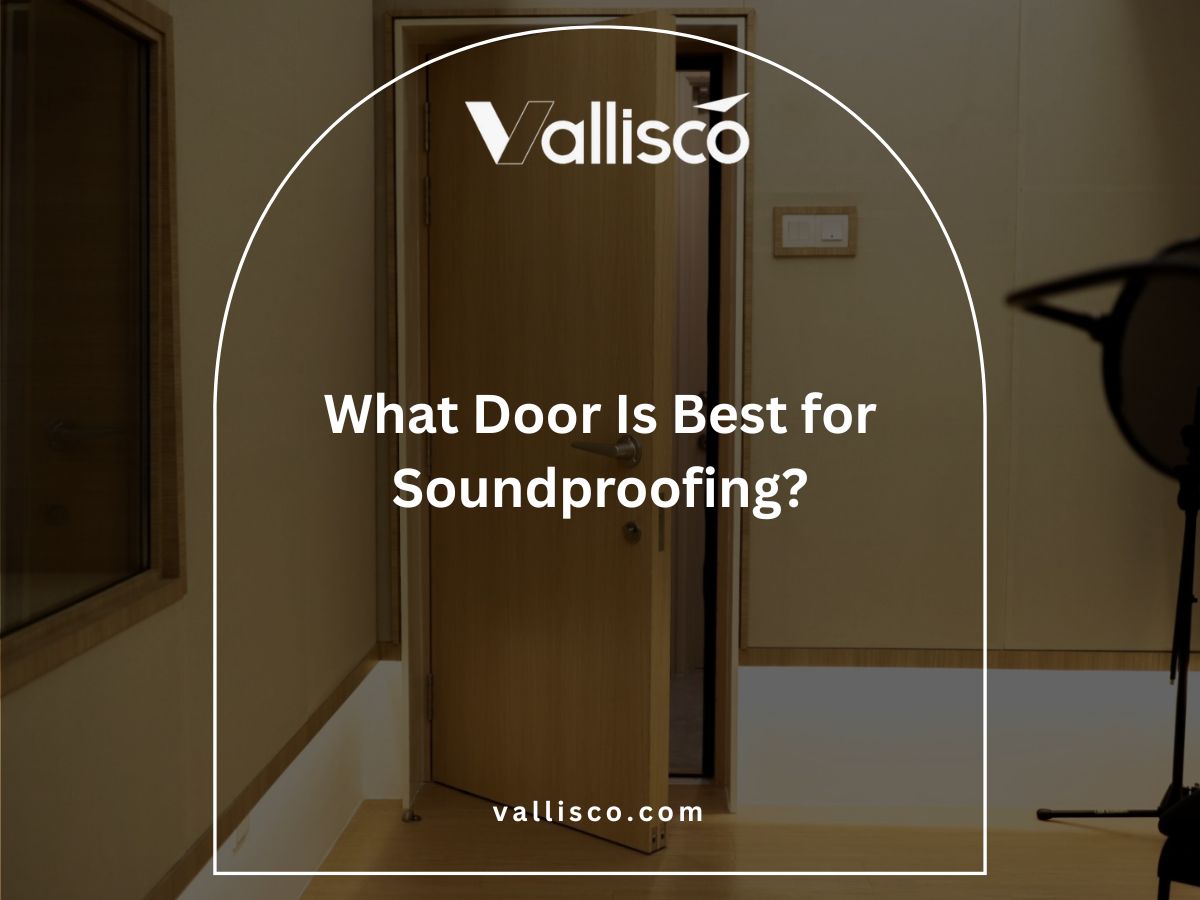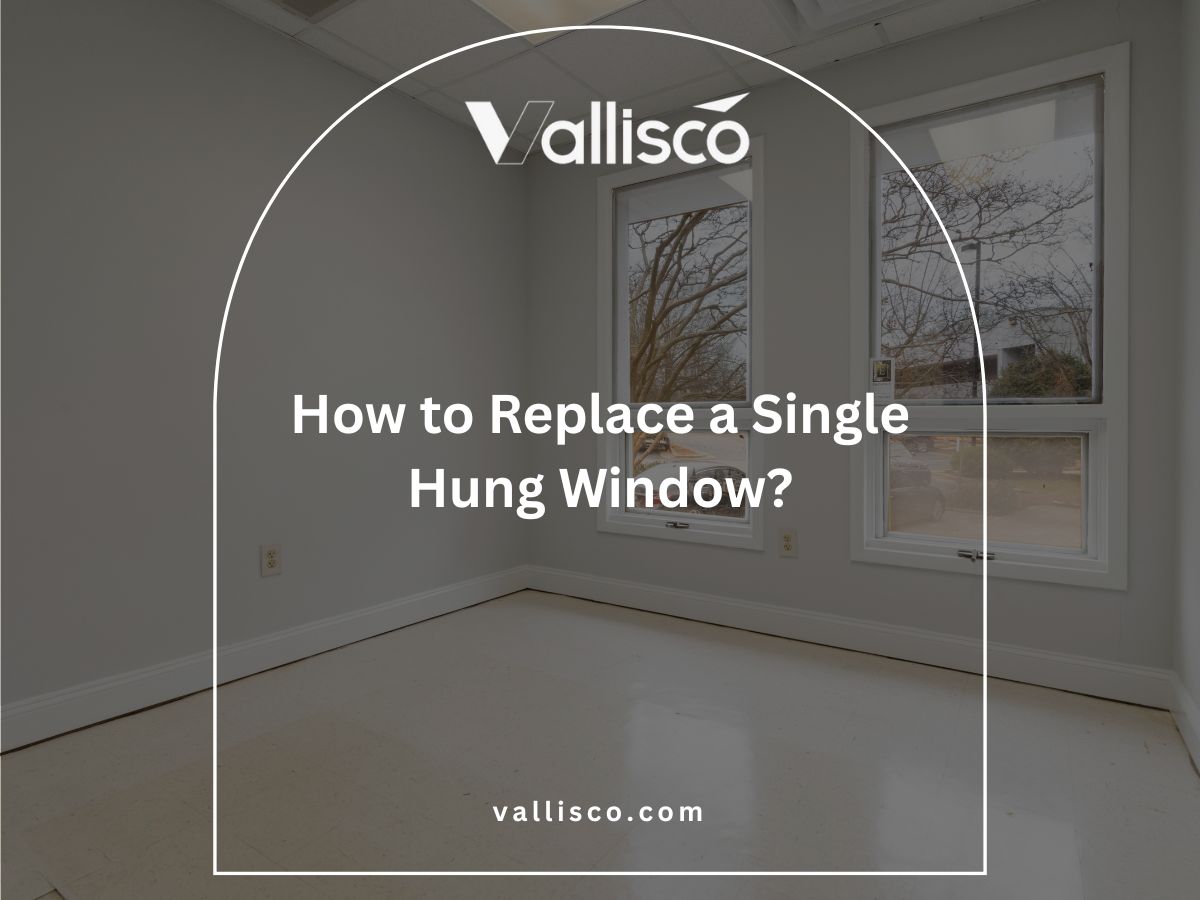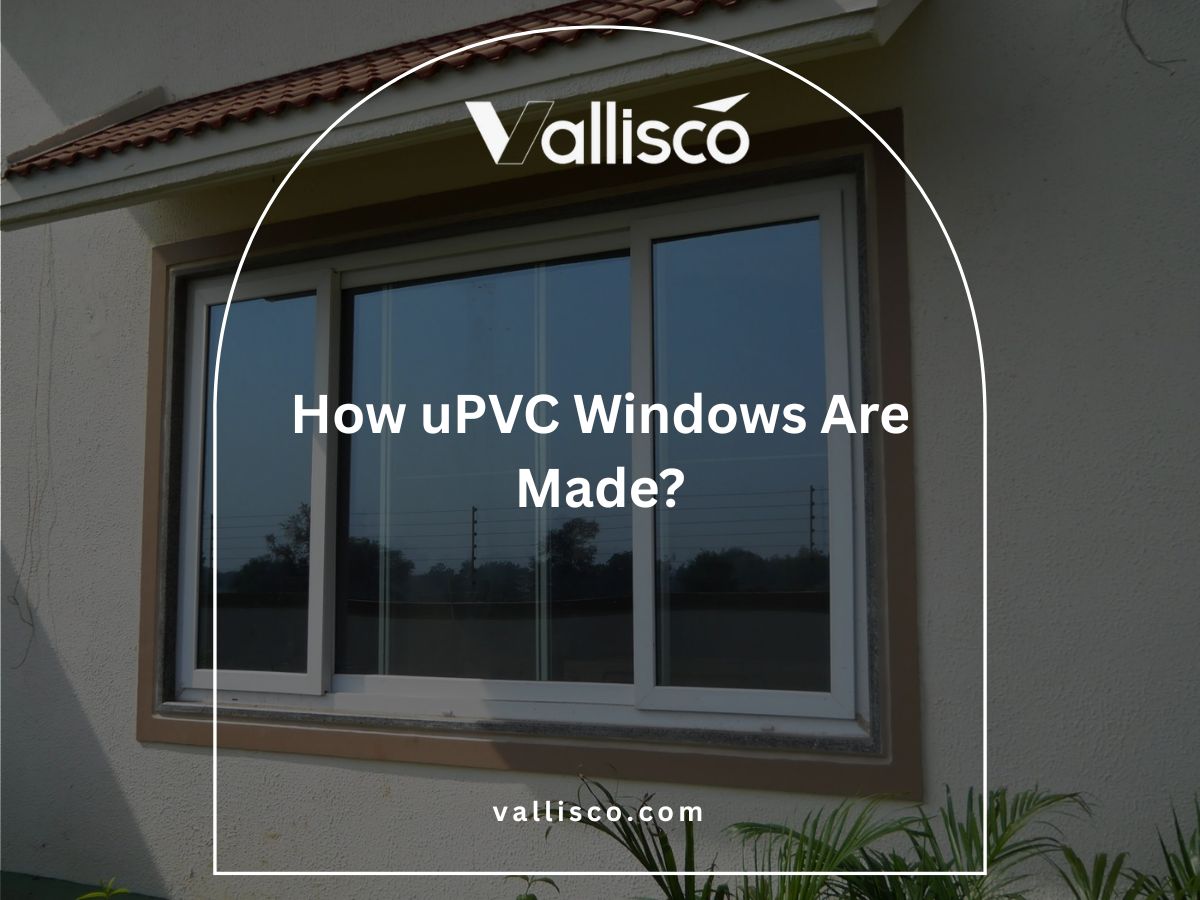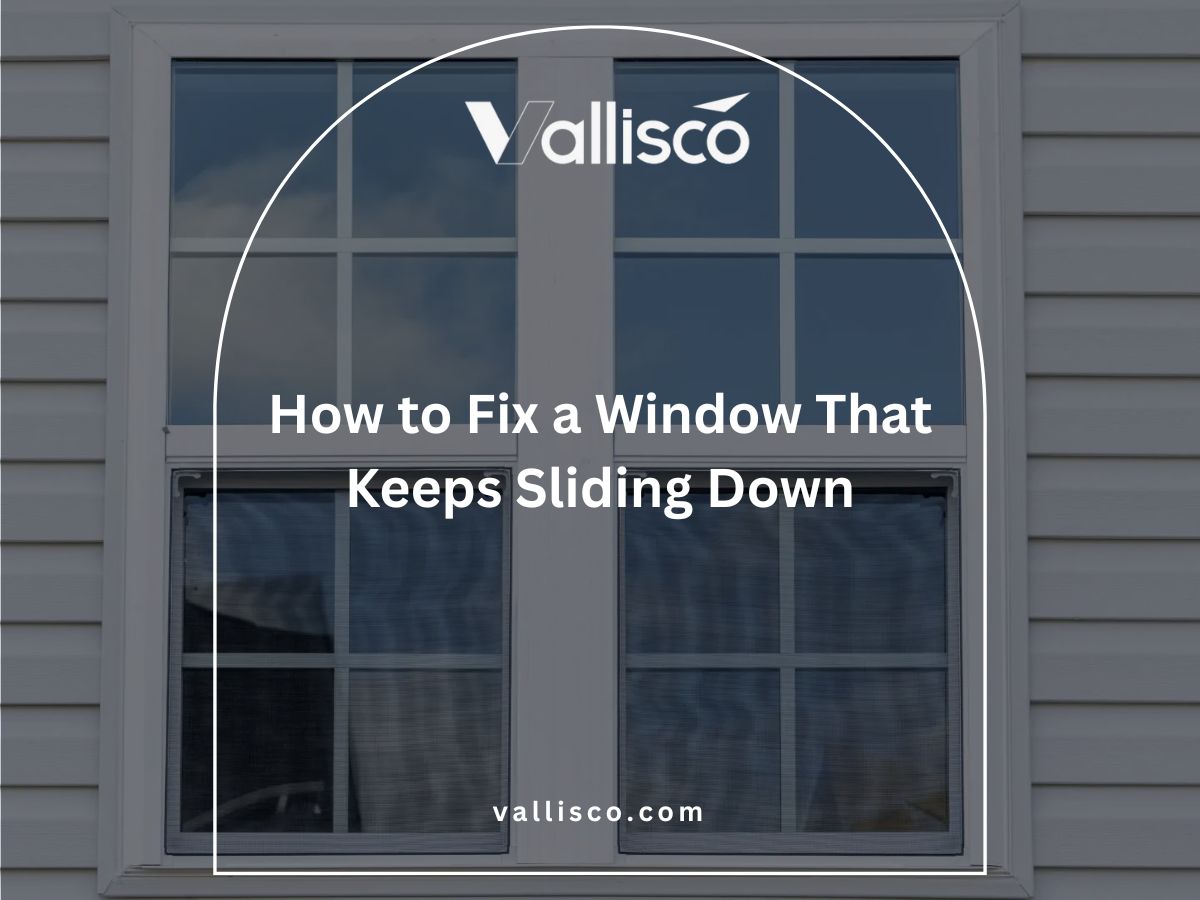Last year, a boutique hotel manager asked me why their fancy new door swelled shut every time it rained. They had no idea the material wasn’t rated for exterior use.
That kind of mistake is easy to avoid if you know what to look for.
I’ve spent years helping hotels choose doors that match their building’s weather, traffic, and design. I don’t sell doors. I help businesses make better picks.
This article lays out 10 types of hotel front doors. You’ll walk away knowing which ones hold up, look good, and actually work for your space.
A good front door isn’t just an entrance. It’s a long-term solution.
So, let’s jump in!
Quick Comparison Chart
Before we dive deeper into each hotel door type, here’s a quick side-by-side comparison to give you a feel for what each one offers.
| Door Type | Best For | Key Advantages | Key Drawbacks |
| Double Leaf Hinged Doors | Formal hotel entries | Classic look, low upkeep | Needs floor space |
| Automatic Sliding Doors | Busy, modern hotels | Hands-free, smooth flow | Needs power and space |
| Revolving Doors | Urban or upscale hotels | Saves energy, luxury feel | Less accessible |
| Swing Glass Doors | Interior or side entry | Clean, light look | Smudges, less insulated |
| Architectural Pivot Doors | Statement or feature entries | Bold design, smooth swing | Hard to seal, costly |
| Security Vestibule Doors | Hotels needing entry control | Safer access, blocks air | Slower entry, takes space |
| Thermal Break Aluminum Doors | Energy-saving locations | Insulated, corrosion-resistant | Not for high traffic |
| Wood-Clad Steel Doors | Warm but secure entries | Strong core, rich finish | Needs upkeep, heavier |
| Bullet/Impact-Resistant Doors | High-risk or urban areas | Strong, discreet protection | Limited designs, long lead |
| Bi-Fold Entry Doors | Hotels with patio access | Wide opening, sleek look | Poor insulation, more parts |
Got a feel for your options? Let’s dive into each door’s details in the next sections.
1. Double Leaf Hinged Doors
Double leaf hinged doors are two-panel doors that open from the center, each swinging in or out on its own hinge. They’re often used at main entrances where a larger opening is needed without going fully automatic. I’ve seen them in older hotels or boutique buildings that still want a formal front.
Advantages
- Clear Entry Separation: One panel can stay locked while the other operates, giving you flexible control for different traffic volumes.
- Symmetrical Design: Creates a balanced, welcoming appearance that fits with both classic and formal hotel fronts.
- Hardware Compatibility: Works with standard locks, panic bars, or closers, so sourcing parts is easy.
- Durable Construction: Can be made with steel, aluminum, or composite materials that hold up well with regular guest use.
- Low Maintenance Costs: Minimal moving parts compared to automatic doors mean fewer service calls over time.
Disadvantages
- Takes Up Floor Space: Panels swing into interior or exterior areas, which can block walkways or furniture setups.
- Less Accessible for Guests with Mobility Needs: Without automation, pushing or pulling can be difficult for some guests.
- Weather Seal Gaps: If not installed tightly, the center meeting point can let in air or water over time.
Recommendation
Double leaf hinged doors are a great pick if you need a strong, simple entrance that looks formal and works without power. But they might not be ideal if your layout is tight or you need something more accessible and modern-looking.

2. Automatic Sliding Doors
Some hotel entries need to work hard without looking busy. Automatic sliding doors do that well, they open smoothly, stay out of the way, and don’t interrupt the flow. I’ve worked with hotel teams who chose this style to give guests a quiet, hands-free welcome that fits modern expectations.
Advantages
- Touch-Free Operation: Guests walk straight through without needing to touch the door, which is helpful for hygiene and convenience.
- Modern Look: Frameless glass or slim aluminum tracks blend well with contemporary hotel exteriors and lobbies.
- Smooth Guest Flow: Opens and closes automatically based on motion, reducing bottlenecks during peak times.
- ADA-Friendly: Makes it easier for guests using wheelchairs, walkers, or pushing strollers and luggage.
- Controlled Access Options: Can be set up with card access or sensors to limit entry after hours without adding extra doors.
Disadvantages
- Higher Installation Cost: Requires electric wiring, sensor units, and precision track systems that increase setup costs.
- Ongoing Maintenance: Needs occasional servicing to keep sensors responsive and the sliding mechanism aligned.
- Wall Space Requirement: You’ll need enough room on one or both sides of the opening to allow the panels to slide fully.
Recommendation
I recommend automatic sliding doors if you want clean, quiet entry with less guest effort and a modern look. But they’re not ideal if your building has limited wall space or you’re avoiding electrical add-ons.
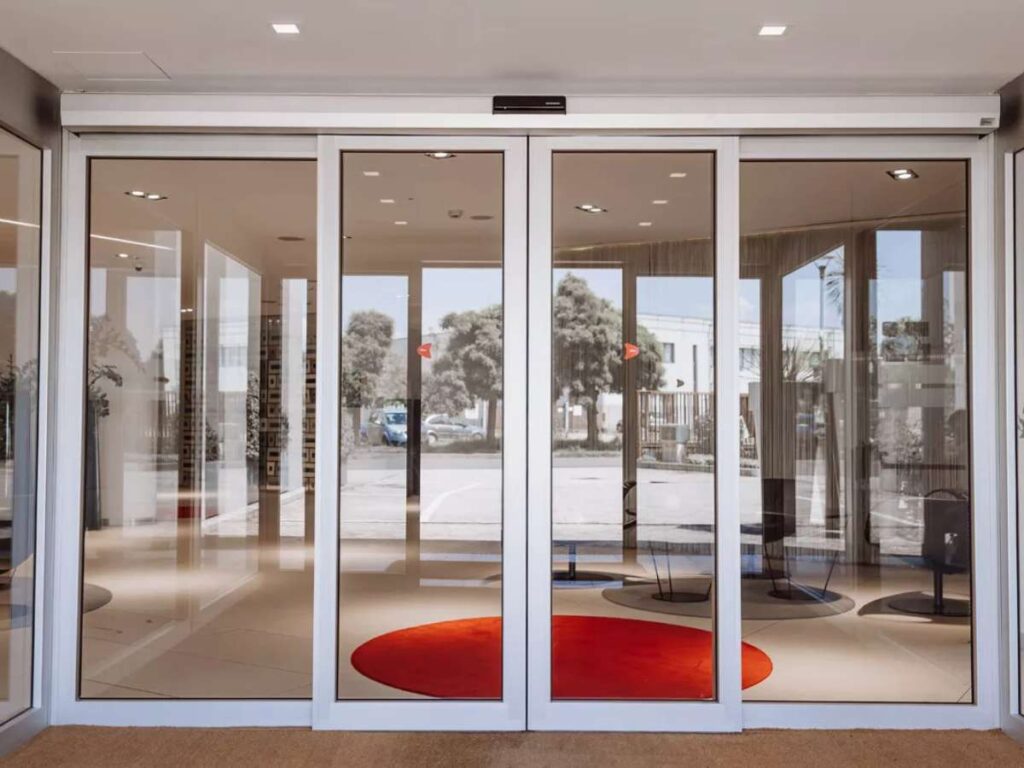
3. Revolving Doors
Revolving doors tend to make a strong first impression, especially in upscale or high-traffic hotel lobbies. They give your entrance a premium feel while also helping manage airflow and temperature. I’ve had hotel clients specifically ask for these to reduce lobby drafts without losing visual appeal.
Advantages
- Energy Control: Minimizes air exchange between inside and outside, helping to keep heating and cooling systems steady.
- Continuous Entry and Exit: Guests can enter and leave at the same time without waiting for doors to close.
- Noise Reduction: Helps block outdoor noise from busy streets or traffic-heavy zones.
- Luxury Appeal: Instantly gives your hotel a high-end, professional look.
- Weather Barrier: Keeps wind, dust, and rain from rushing in during storms or strong seasonal changes.
Disadvantages
- Not Ideal for Emergency Exits: Slows down quick movement during emergencies unless paired with side swing doors.
- Harder for Some Guests to Use: May be tricky for elderly guests or those with mobility devices unless automated.
- More Expensive to Maintain: Moving parts and rotation systems require specialized servicing.
Recommendation
Revolving doors are best for large hotels in city centers or cold climates where energy savings and guest comfort are top priorities. But if your space is tight or you have a lot of guests with accessibility needs, you might want a simpler entry.
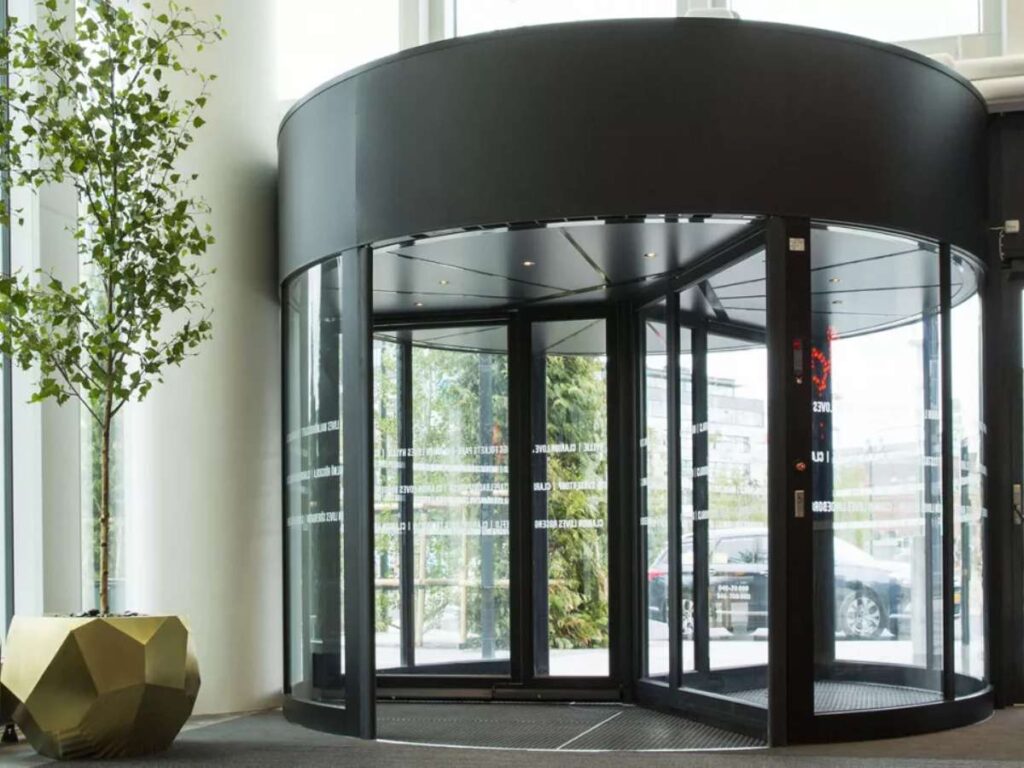
4. Swing Glass Doors (Manual or Power-Operated)
Swing glass doors are hinged doors made of clear or frosted glass that open like a regular swing door. You’ll often see them used between lobbies, spa areas, or lounges where a clean look matters. I’ve noticed they’re a go-to when hotels want something sleek but not overly complicated.
Advantages
- Modern Visual Appeal: These doors bring in light and create a more open, welcoming feel. They work especially well for boutique hotels or renovated spaces.
- Flexible Operation: You can choose manual for simplicity or add automation for easier access. This makes it adaptable for different hotel zones.
- Space-Saving Option: Since they swing instead of slide, they don’t need wall clearance like sliding doors. They’re useful for narrower entry points.
- Good for Interior or Secondary Entrances: Often used inside lobbies, spa areas, or between reception and lounges. They give a high-end look without complex framing.
- Simple Retrofit: These doors can often fit into existing door frames. That means fewer changes during upgrades or remodels.
Disadvantages
- Can Show Smudges and Dirt Easily: Fingerprints and streaks stand out more on glass than on solid materials. This means more frequent cleaning.
- Limited Weather Blocking: Glass swing doors usually don’t seal as tightly as heavier door types. They’re not ideal for harsh climates or noisy streets.
- Manual Versions Less Accessible: Without a power assist, guests with limited mobility may struggle to open them. This can affect guest comfort.
Recommendation
Swing glass doors are a solid choice if you’re upgrading indoor zones or want a clean, modern entry with minimal changes. But they fall short if you’re dealing with strong outdoor elements or need better sound control at the front door.
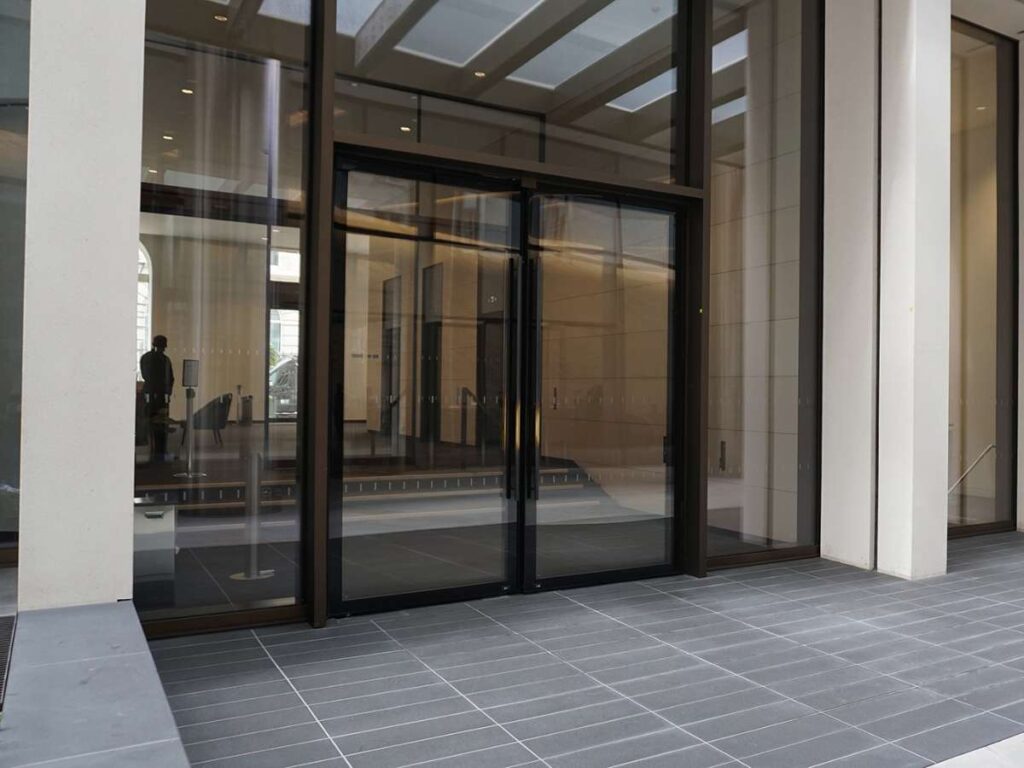
5. Architectural Pivot Doors
Architectural pivot doors rotate on a central or offset pivot instead of standard side hinges. They’re often large, statement-making doors that swing with a smooth, slow motion. One hotel I worked with installed one as a showpiece entry, and it instantly changed how guests viewed the space.
Advantages
- Striking Visual Impact: These doors immediately stand out due to their large size and unusual movement. Guests notice them, and that can help reinforce your brand.
- Smooth, Balanced Movement: The pivot mechanism distributes weight evenly. Even heavy doors feel light to open.
- Wide Design Options: You can build them with wood, metal, or glass. That makes it easier to match your building’s look.
- Custom Sizing: These doors are not limited to standard widths or heights. Great for oversized openings or feature entrances.
- Clean Hardware Aesthetic: Since the pivot points are often hidden, there’s no bulky hardware on display. That gives your entry a clean, uninterrupted surface.
Disadvantages
- Costly to Install: Pivot systems and oversized custom panels often require structural adjustments. This raises both material and labor costs.
- Takes Planning to Seal Properly: Because of how they swing, it can be hard to get a tight weather or sound seal. That can affect comfort in certain climates.
- Not Ideal for High Traffic: In very busy entries, the one-panel swing motion can slow things down. It’s more of a feature door than a workhorse.
Recommendation
Architectural pivot doors are a strong fit if you want your hotel to make a bold first impression with a standout entry. But they’re not the best option if you’re focused on tight seals, high traffic flow, or long-term maintenance savings.
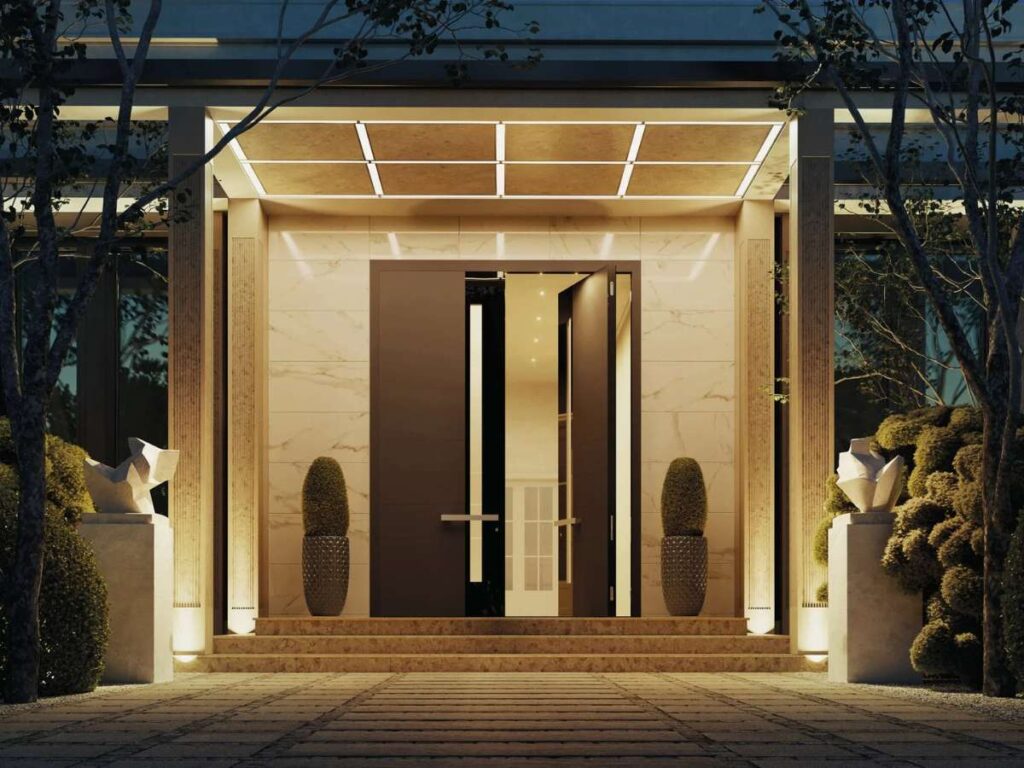
6. Security Vestibule Doors
Security vestibule doors use two entry points with a small enclosed space between them. They help manage who enters your hotel while adding a layer of environmental control. I know several hotel managers who needed better overnight security without hiring extra staff, and vestibules gave them that balance.
Advantages
- Controlled Access Flow: The two-door setup forces entry one step at a time. This makes it harder for unauthorized people to slip in.
- Added Safety at Night: Vestibules can be locked down or monitored remotely. That adds peace of mind during overnight hours.
- Environmental Buffer: The enclosed space helps reduce wind, dust, and temperature swings from reaching the lobby. Vallisco designs vestibule door systems that improve lobby comfort by controlling external elements and maintaining indoor stability.
- Custom Security Features: Can be fitted with card readers, intercoms, or security cameras. You get more control without needing a guard at all times.
- Professional Look: Gives your building a high-security appearance without being too aggressive. It’s discreet but effective.
Disadvantages
- Slower Entry Times: Guests must go through two doors, which can create small delays, especially at busy times.
- More Space Required: You need room for both door sets and the buffer area. This may not fit older buildings with tight layouts.
- Higher Upfront Cost: Extra framing, locks, and electronics add to the total price. Maintenance is also a bit more involved.
Recommendation
I can see that security vestibule doors are a smart choice if you want to control access without relying on staff or visible barriers. But they may not suit smaller hotels where space is limited or where fast guest movement is more important than added security.
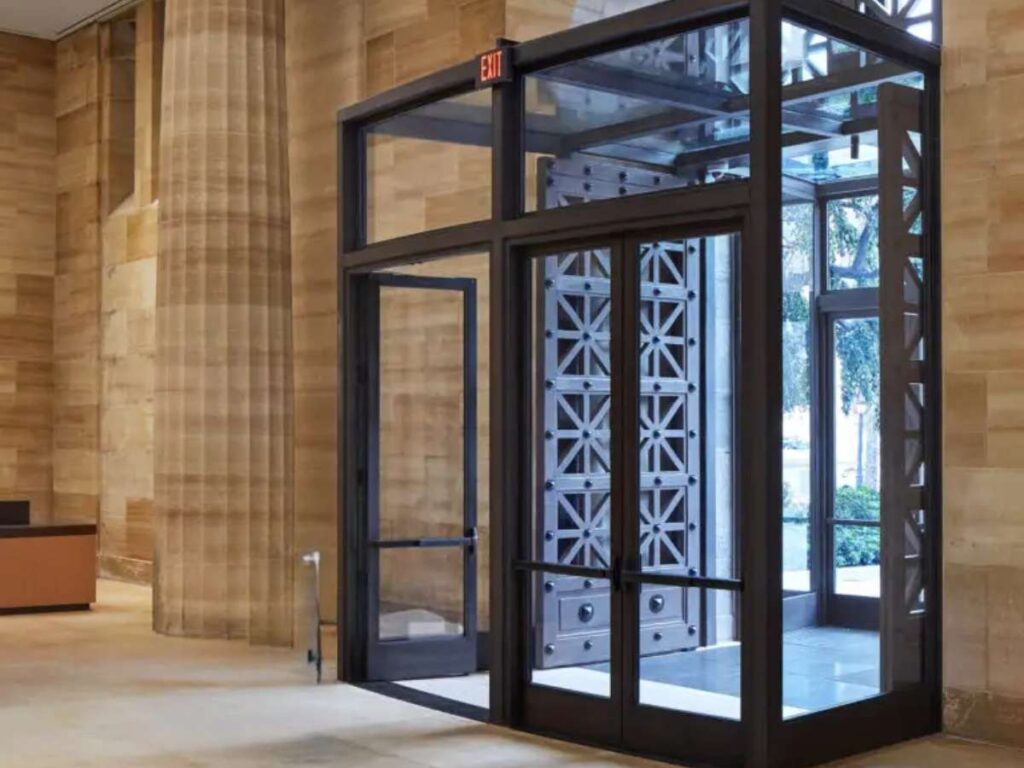
7. Thermal Break Aluminum Doors
Thermal break aluminum doors are built with a layer of insulation between the inner and outer aluminum frames. This helps reduce heat loss and keeps indoor temperatures more stable. I’ve installed these on hotels in colder regions where energy costs were getting out of hand.
Advantages
- Improved Energy Efficiency: The thermal break cuts down on heat transfer between outside and inside. That means better climate control year-round.
- Strong and Lightweight: Aluminum frames stay sturdy without adding too much weight. Easier for installers and daily use.
- Corrosion Resistant: Aluminum naturally resists rust, making it a good option for coastal or humid environments.
- Low Maintenance Finish: Powder-coated or anodized surfaces hold up well without constant upkeep. That keeps your entry looking sharp.
- Modern Design Flexibility: These doors can fit into sleek storefronts or minimalist hotel styles. They look clean and professional.
Disadvantages
- Higher Material Cost: The insulated frame system costs more than basic aluminum doors. That adds to your overall budget.
- Not Ideal for Heavy Traffic Areas: While durable, the frame might not handle the same wear as stainless or steel options in very busy hotels.
- Requires Proper Sealing: If not installed correctly, you lose the energy-saving benefits. It takes skilled hands to get it right.
Recommendation
Thermal break aluminum doors are a good match if your hotel needs to manage heating and cooling without losing that modern, clean look. But they might not be the best fit for high-traffic zones or projects where upfront cost is the top concern.
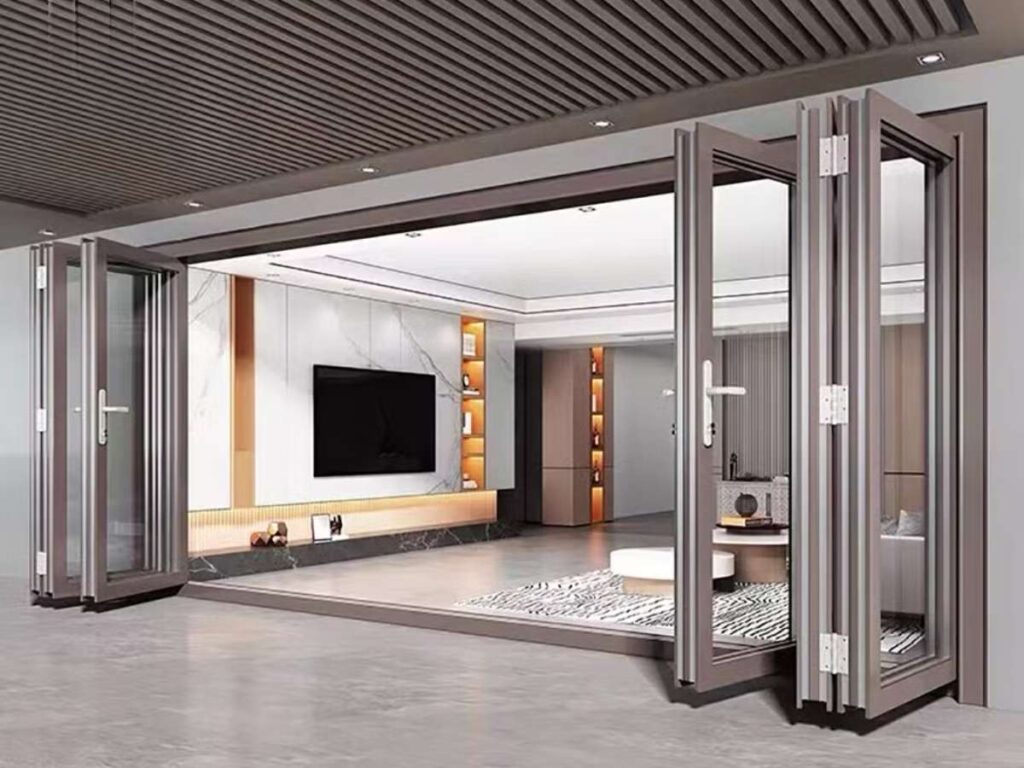
8. Wood-Clad Steel Doors
Wood-clad steel doors combine a steel core for strength with a wood finish on the outside for visual warmth. They offer a solid structure with a more natural, inviting look. I’ve been part of hotel projects where clients wanted the durability of metal without giving up the feel of real wood.
Advantages
- Strong Core Structure: The steel inside gives it excellent resistance to warping, bending, or forced entry. Great for busy entrances or higher security needs.
- Warm Exterior Finish: The wood surface softens the look, helping the door blend into rustic, boutique, or upscale designs.
- Weather-Resistant Options: Many models come pre-treated or sealed to hold up against moisture, sun, and temperature swings.
- Better Insulation Than Plain Steel: The wood cladding adds a layer that helps reduce thermal transfer. That’s useful in hotels trying to manage indoor climate.
- Custom Design Flexibility: You can choose different wood types, stains, or grains. This makes it easier to match your building’s personality.
Disadvantages
- Requires More Maintenance: Wood finishes need touch-ups or sealing over time, especially in wet or sunny climates.
- Heavier Than Standard Doors: The steel core plus wood surface adds weight, which may require stronger hardware and framing.
- Higher Cost Than Basic Options: You’re paying for both appearance and strength, so it’s more expensive than standard steel or wood doors.
Recommendation
Wood-clad steel doors are best if your hotel needs durability but still wants to offer a warm, welcoming look at the entrance. But they may not be ideal for properties trying to avoid maintenance work or extra installation costs.
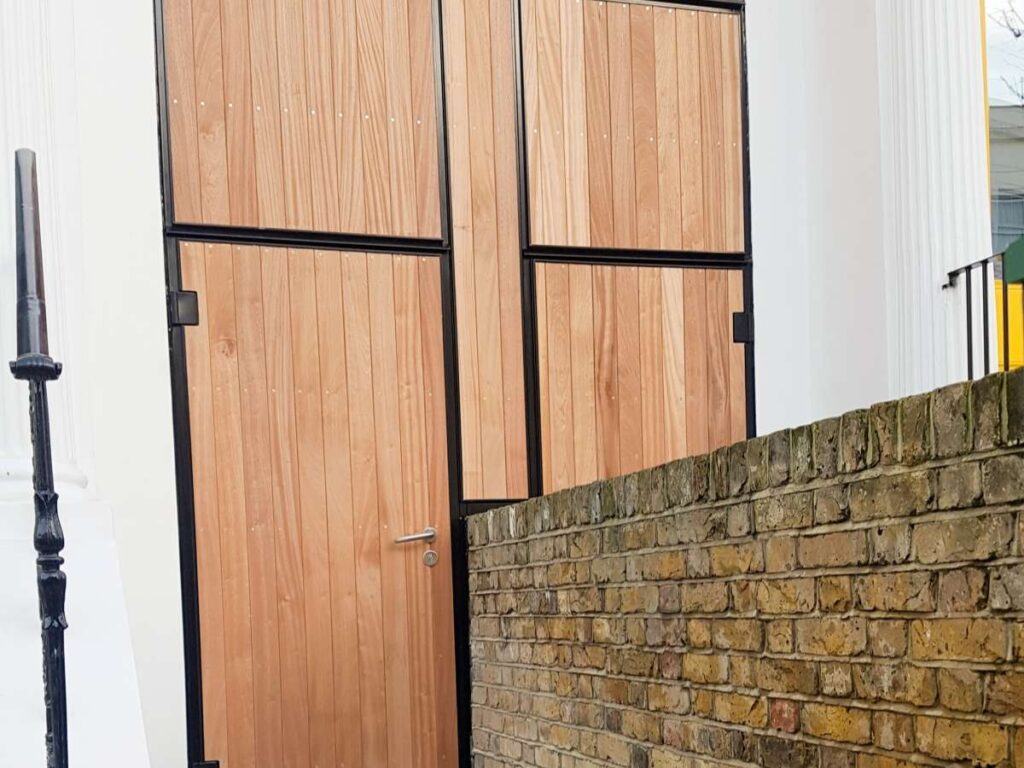
9. Bullet-Resistant or Impact-Resistant Doors
These doors are built to protect against forced entry, heavy blows, or even ballistic threats, depending on the rating. They’re commonly used in hotels located near high-traffic areas, government zones, or places that prioritize added guest safety. I like how these doors bring peace of mind without making your entrance look like a fortress.
Advantages
- Enhanced Security Levels: Rated to resist bullets, blunt force, or break-in attempts. A smart choice for hotels needing next-level protection.
- Solid, Durable Construction: Made from layered steel, composites, or reinforced glass. These doors hold up under pressure without showing weakness.
- Discreet Appearance: They can look like standard doors from the outside. That means you get security without drawing unwanted attention.
- Good for High-Risk Locations: Useful in areas with higher crime rates or where guest safety is a top priority.
- Optional Fire Ratings: Some models offer both impact resistance and fire protection, reducing the need for separate systems.
Disadvantages
- Heavier Build: The added layers and reinforcements make them harder to install and operate without proper support hardware.
- Limited Design Flexibility: These doors often come in standard looks. If you’re aiming for a specific aesthetic, your options may be fewer.
- Longer Lead Times: Due to their specialized nature, these doors may take longer to manufacture and deliver compared to regular models.
Recommendation
Bullet-resistant or impact-resistant doors are a smart fit for hotels that prioritize guest safety, especially in urban or sensitive areas. But they might not suit properties that need fast turnaround or more freedom in visual design.
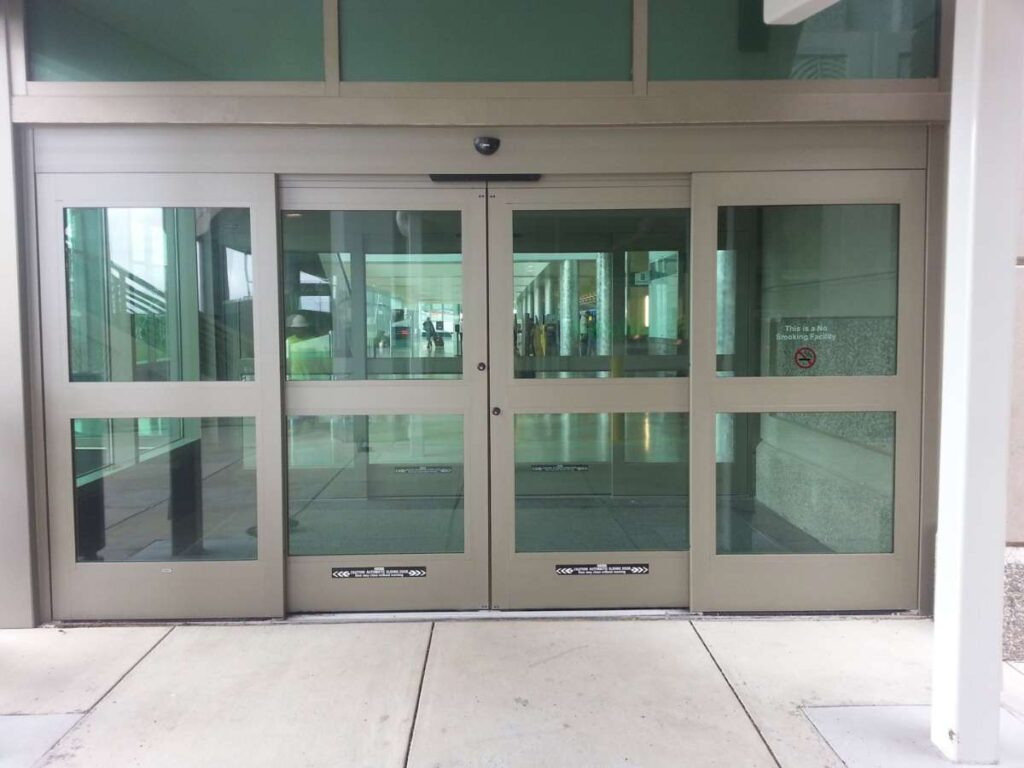
10. Bi-Fold Entry Doors
Bi-fold entry doors fold to the side in sections, creating a wide opening without taking up much swing space. They’re often used in hotels with courtyards, patios, or event spaces that connect indoor and outdoor areas. What impressed me most is how they give hotels the flexibility to open up the space when needed, without losing the structure of a secure door.
Advantages
- Wide Opening Capability: The folding design clears the full width of the doorway. Perfect for moving large groups or opening up to outdoor spaces.
- Flexible Access Control: You can open one panel or the whole set, depending on foot traffic. This gives you day-to-day control.
- Blends Indoor and Outdoor Areas: Great for hotel restaurants, lounges, or lobbies that lead to terraces or gardens. Guests enjoy seamless movement.
- Modern, Upscale Look: Bi-fold doors offer a clean and contemporary appearance. They instantly make entrances look more open and inviting.
- Compact Stack Storage: When fully opened, the folded panels tuck neatly to the side. That keeps the doorway clear without needing extra wall space.
Disadvantages
- More Moving Parts: The track and hinge systems can wear over time. Regular checks are needed to keep everything sliding smoothly.
- Less Insulated Than Solid Doors: With multiple panels and joints, heat and sound can leak through more easily. Not ideal for temperature-sensitive areas.
- Not for Every Climate: In locations with heavy rain, snow, or strong winds, these doors may not perform as well year-round.
Recommendation
I suggest Bi-fold entry doors if your hotel has shared indoor-outdoor spaces and you want flexibility without a bulky design. But they may not be the best choice for harsh climates or spots where insulation is a top priority.
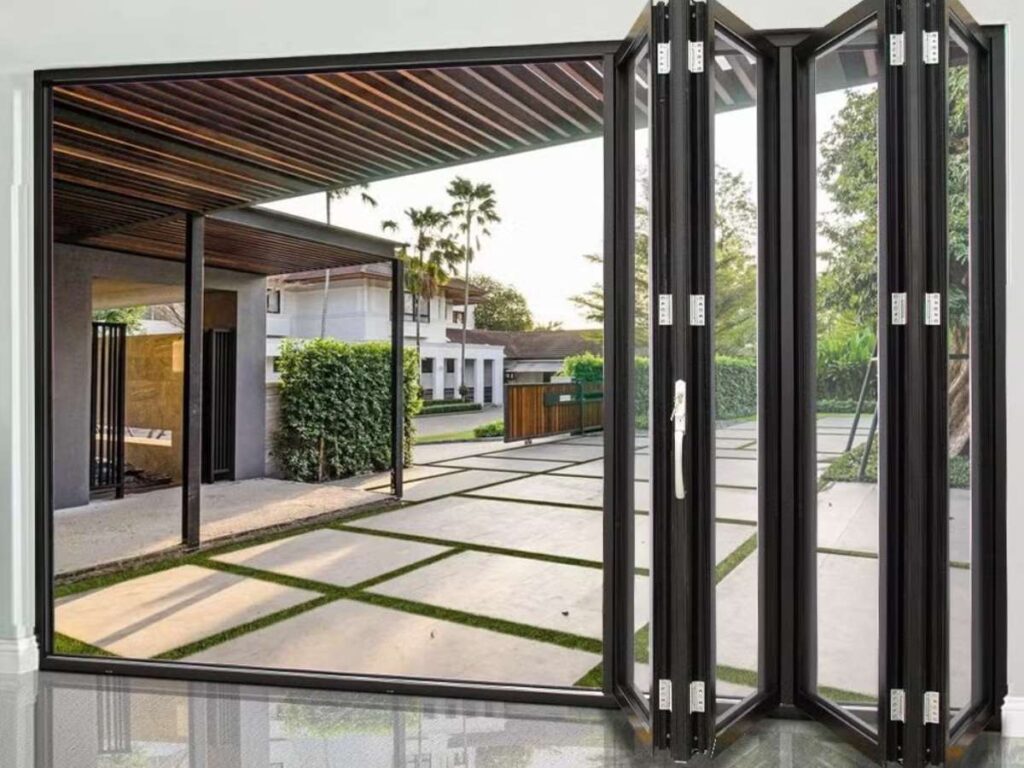
4 Factors To Consider When Choosing The Right Hotel Front Door
A lot of hotels end up changing their front door because the first choice didn’t match their building’s needs. Here are four key points to help you pick a door that actually works long-term:
#1 Guest Traffic and Flow
Start with how many people pass through your entrance each day. Hotels with steady guest movement need a door that opens smoothly and doesn’t block the flow. Hinged doors can slow things down during peak hours, while sliding or revolving doors often handle larger crowds more efficiently.
#2 Climate and Location
Weather plays a bigger role than most people think. Hotels in cold, wet, or windy areas need doors that seal well and keep energy use in check.
I always suggest checking how well the door blocks drafts, rain, and outside noise before locking in your choice.
#3 Security Needs
Not all hotels need high-level protection, but every entrance should match its surroundings. A basic swing door might be enough for quiet areas, while city hotels may need extra layers like vestibules or impact-rated doors.
#4 Maintenance and Longevity
A front door should perform well for years without constant attention. Some materials break down faster, and not all systems are easy to maintain.
Working with a supplier like Vallisco gives you more than just a door. You get expert insight on long-term performance, local conditions, and the right fit for your building.
Conclusion
That boutique hotel with the swollen door fixed the problem by choosing a better fit. Guest complaints dropped, and the entrance finally worked the way it should.
This article gave you 10 solid options with real pros and cons. The right front door isn’t just about looks. It impacts safety, comfort, and flow.
If you’re still thinking it through, go back to the list. Each option solves a different need.
Want help choosing the right door for your hotel?
Contact Vallisco today and let’s find the front door your hotel deserves!
Discover More Options
For more helpful content, explore our collection of recommended reads:
Still haven’t found what you’re looking for? Don’t hesitate to contact us. We’re available around the clock to assist you.



